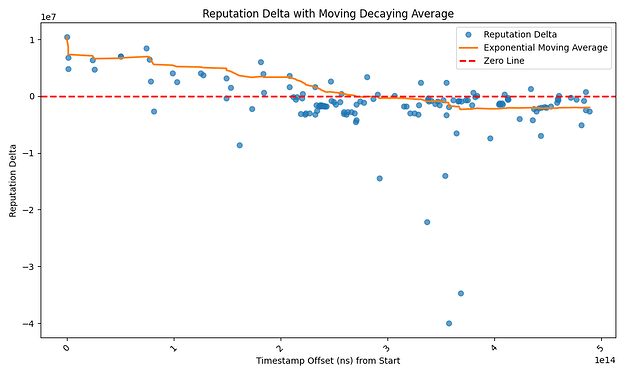Yes, we’re looking at forwards over a series of incoming channels, so so reputation will fluctuate with the incoming channel and the HTLC amount.
Script we used for outliers and a graph with no outlier removal here.
import sys
import os
import pandas as pd
import matplotlib.pyplot as plt
import numpy as np
from datetime import datetime, timedelta
if len(sys.argv) != 3:
print("Usage: python reputation_graph.py <file> <channel_id>")
sys.exit(1)
file_path = sys.argv[1]
channel_id = int(sys.argv[2])
# Load CSV data
df = pd.read_csv(file_path)
# Ensure ts_offset_ns column exists and convert to datetime
df['ts_offset_ns'] = pd.to_numeric(df['ts_offset_ns'])
# Normalize ts_offset_ns to start from zero
df['normalized_ts_ns'] = df['ts_offset_ns'] - df['ts_offset_ns'].min()
# Filter for the specified outgoing channel ID
df_filtered = df[df['outgoing_channel_id'] == channel_id].copy()
# Check if the filtered DataFrame is empty
if df_filtered.empty:
print(f"No data found for outgoing_channel_id {channel_id}.")
sys.exit(1)
# Sort by normalized timestamp
df_filtered = df_filtered.sort_values(by='normalized_ts_ns')
# Calculate reputation delta
df_filtered['reputation_delta'] = (
df_filtered['outgoing_reputation'] - df_filtered['in_flight_risk']
- df_filtered['htlc_risk'] - df_filtered['incoming_revenue']
)
# Remove outliers
outlier_threshold = 1
if len(df_filtered['reputation_delta']) > 0:
lower_percentile = np.percentile(df_filtered['reputation_delta'], outlier_threshold)
upper_percentile = np.percentile(df_filtered['reputation_delta'], 100 - outlier_threshold)
df_smooth = df_filtered[(df_filtered['reputation_delta'] >= lower_percentile) & (df_filtered['reputation_delta'] <= upper_percentile)]
else:
df_smooth = df_filtered
# Calculate Exponential Moving Average (EMA)
alpha = 0.01 # Adjust for decay rate
if not df_smooth.empty:
df_smooth['ema'] = df_smooth['reputation_delta'].ewm(alpha=alpha).mean()
# Plot
plt.figure(figsize=(10, 6))
plt.plot(df_smooth['normalized_ts_ns'], df_smooth['reputation_delta'], 'o', label='Reputation Delta No Outliers', alpha=0.7)
plt.plot(df_smooth['normalized_ts_ns'], df_smooth['ema'], label='Exponential Moving Average', linewidth=2)
plt.axhline(0, color='red', linewidth=2, linestyle='--', label='Zero Line')
plt.title('Reputation Delta with Moving Decaying Average')
plt.xlabel('Timestamp Offset (ns) from Start')
plt.ylabel('Reputation Delta')
plt.xticks(rotation=45)
plt.legend()
plt.tight_layout()
# Save graph
output_dir = os.path.dirname(file_path)
file_name = os.path.basename(file_path).rsplit('.', 1)[0]
output_path = os.path.join(output_dir, f"{file_name}_reputation.png")
plt.savefig(output_path)
print(f"Graph saved to {output_path}")
else:
print(f"No data available to plot after outlier removal for channel_id {channel_id}.")
Turns out there isn’t much of a difference for this experiment - in some of the others there was one large negative point which made it difficult to see the gradient of the exponential moving average.
Correct.
For honest node A to be able to send endorsed payments to T, they need to have paid T enough in the last 6 months over A-T to compensate them for their revenue from T-B. So while T hasn’t been paid by the attacker, they’ve still been compensated for the damage that abusing that reputation can do.
Where bi-directional reputation helps is that it forces the attacker to pay to attach to this chain of existing reputation; without it, M0 can take advantage of A’s reputation with T without compensating A at all.
The issue here doesn’t seem to be compensation under attack, but rather how this chain of nodes will recover after an attack. If we think about this in multiple “rounds” of two weeks (the period our reputation algorithm looks at):
- Round 1: attacker builds reputation and jams, nodes are compensated
- Round 2: attacker has lost reputation from attack, but chain has lost reputation
Since we’re aiming to protect revenue, not reputation itself, the chain of honest nodes runs into issues if they’re general jammed in round 2 because some nodes’ reputation will have been knocked out and they’re not able to re-build it using general resources.
This is because:
- Reputation is only focused on a 2 week horizon, so it is only compensating for that period exactly.
- General jamming is trivial for an extended period of time.
We’re going to look into some options for both of these!
I don’t think that this can easily be translated to a loop. If T0 has enough reputation with T1 to get 8 HTLCs in flight, the T0-T1 channel will be quite valuable to T0. Transitively, M0 will need to meet quite a high threshold to get to that one endorsed HTLC, and will have to compensate T0 accordingly. My intuition is that it wouldn’t work out so advantageously for the attacker here, but we can take a look at some numbers.
Cheers,
Clara (posting on Carla’s behalf while she’s OOO)
